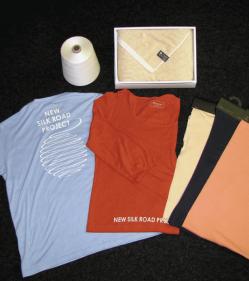19/12/2013
SILK DIVERSITY: “Eri Nature” - Natural Functional Fiber Using Biodiversity
The number of “silk” species existing as resources on earth number more than one hundred thousand. Silk is not only produced by silkworms, but also by other insects including most moths, butterflies, and some coleopterons or locusts. In the case that spiders are included, the number of such insects becomes even greater. How and why do these insects produce silk? This question led me to start my silk research.
Embioptera have hairy front legs. They expel 200 very fine silk fibers from their legs like a Kabuki actor and make their nests. Hydrophilidae produce silk by expelling silk fibers from their rumps and cover their eggs with cocoons. The organs for producing silk fiber are diverse. Silkworms produce it in their salivary glands. Some produce it in their gastrointestinal tracts, and the others produce it in organs derived from gonads. The silk respectively has slightly different chemical compositions and nanostructures.
Last year, “Eri Nature,” marvelous fibers, jointly developed by Shikibo Co., Ltd. and Tokyo University of Agriculture, won the Kids’Design Award. The fibers use the silk produced by the Eri Silkmoth, Samia cynthia ricini, belonging to Saturniidae. Its fibers are very fine and soft, but its baves (1) are not long like the ones of silkworms. Therefore, the fibers of the Eri Silkmoth are rarely used. However, a few centimeters of short baves are enough for making wool or cotton fibers. Then, I suggested that fibers could also be made from Eri silk by using the same method as wool or cotton. I directly negotiated with Shikibo Co., Ltd. regarding this idea. “Why don’t we make a new silk making the best use of Japanese wisdom and technologies? It is high time for us to work on it.” That was 4 years ago. Then, it took 2 years to develop “Eri Nature.”
The fiber of Eri silk is not as shiny as usual silk, but soft and unslippery. In addition, the fiber is light, filters out UV rays (both UV-A and UV-B), and eliminates odors such as ammonia. These characteristics are related to the original nanostructures of Eri silks. Most natural fibers have to be chemically processed in order to produce functionalities. However, as Eri Nature originally has functions in fabrics, it is not necessary to process the silks chemically. Eri Nature is “naturally functioned fibers.” Therefore, Eri Nature is safe both for children and old people. I use Eri Nature T-shirts and towels regularly. They dry quickly and clear away odors. Moreover, Eri Nature is washing machine-safe.
Major habitats of Eri Silkmoths are located in Southeast Asia. One of the important aims of this project is to support farmers in Cambodia. The Eri Silkmoths produce cocoons by eating the leaves of cassava. The pupas are esteemed highly as a significant source of protein. Cassava breed Eri Silkmoths in the leaves while producing tubers as food. Shikibo has conducted a project in line with the Convention on Biological Diversity, based in Cambodia, a major habitat of Eri Silkmoths. It is hoped that “manufacturing” using silk diversity can be expanded to the world.











